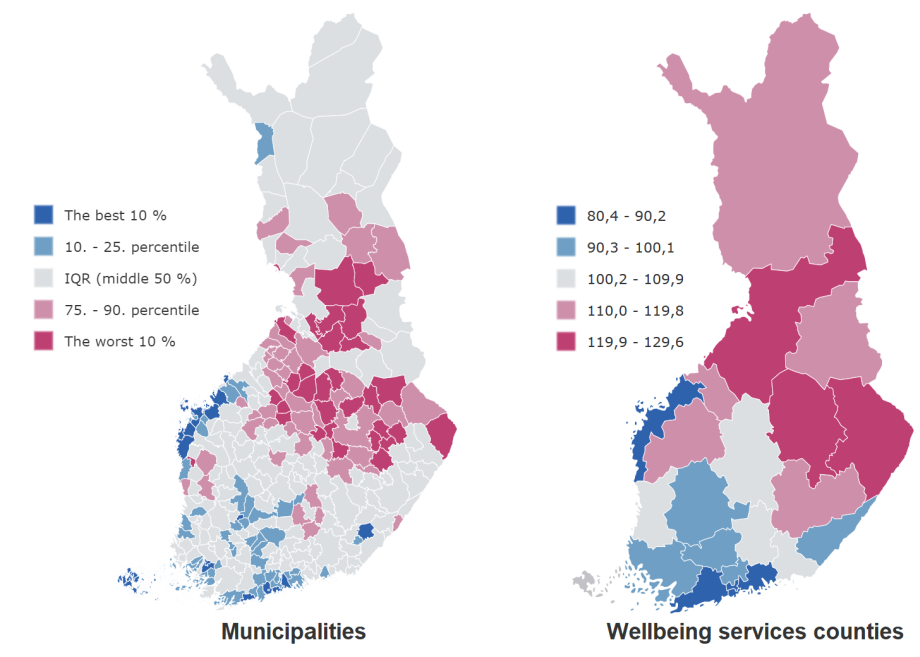Morbidity Index: Apparent differences between the wellbeing services counties, but morbidity has decreased throughout the country
There are substantial differences in morbidity between the wellbeing services counties. According to the morbidity index, the healthiest Finns live in the Helsinki Metropolitan Area and Ostrobothnia, the morbidity is highest in North Savo, North Ostrobothnia and North Karelia. The traditional east-west division remains clearly visible with eastern Finland having a greater prevalence of diseases and western Finland being healthier.
In the comparison of cities with more than 50,000 inhabitants, morbidity is highest in Kuopio, Oulu and Kotka, and lowest in Espoo and Helsinki. Although the situation in cities with the highest morbidity appears to be partly due to different diseases, the common factor is that musculoskeletal disorders and severe mental disorders are more common than average.
The differences in morbidity are due to reasons related to living conditions, lifestyles, hereditary factors and health care activities. The results do not describe the possible impacts of the service and care debt resulting from the treatment of the coronavirus epidemic, as the time series does not extend to the coronavirus epidemic.

Figure 1. Morbidity index in municipalities and wellbeing services counties in 2017-2019. The reference figures are age-standardised, which means that the effect of the different age structures in the counties has been eliminated. (Whole country = 100.)
Different trends in morbidity sub-indices
The morbidity rate of Finns has decreased steadily throughout the 2000s. However, different trends are observed by disease group. For example, the cancer index has increased slightly while the index for musculoskeletal disorders has decreased in 2000-2019 in different parts of the country.
"There are different factors behind the trends of disease groups. The cancer index describes the incidence of cancers, and the increase in the index is due, among other things, to the development of early cancer diagnostics. The musculoskeletal disorders index, on the other hand, describes the share of working-age people who are on disability pension due to musculoskeletal disorders. Its decline is due , among other things, to a decrease in the number of long-term and burdensome musculoskeletal disorders, but probably also to changes in the criteria for granting disability pension", says Research Professor Seppo Koskinen from THL.
The morbidity index describes the morbidity rate of the population in municipalities and regions in relation to the whole country with a reference figure of 100. The smaller the city’s, municipality’s or county’s number, the healthier the population.
Interpretation of the morbidity index
The morbidity index takes into account seven serious disease groups and four different weighting perspectives. The disease groups included in the index are cancers, coronary disease, cerebrovascular diseases, musculoskeletal diseases, mental health problems, accidental injuries and dementia.
Both an age-standardised version of the morbidity index and a version not age-standardised are published. The age-standardised results level out the effects of age structures, so the results can be used in comparisons between regions. The non-standardised index, in turn, describes the actual burden of disease in the region as it takes into account the number of elderly people.
The now updated morbidity index is based on information from the period 2000–2019. In the future, data production will be developed into a new national health index.
Further information
Results as maps and profiles in the Terveytemme.fi service
Results as tables and open data in the Sotkanet.fi service
Seppo Koskinen
Research Professor
Finnish Institute for Health and Welfare
Tel. +358 29 524 8762
firstname.lastname@thl.fi
Timo Koskela (assistance for the media in data matters)
Senior Planning Officer, Finnish Institute for Health and Welfare
Tel. +358 29 524 6845
firstname.lastname@thl.fi



